#Mycenaean art
Text
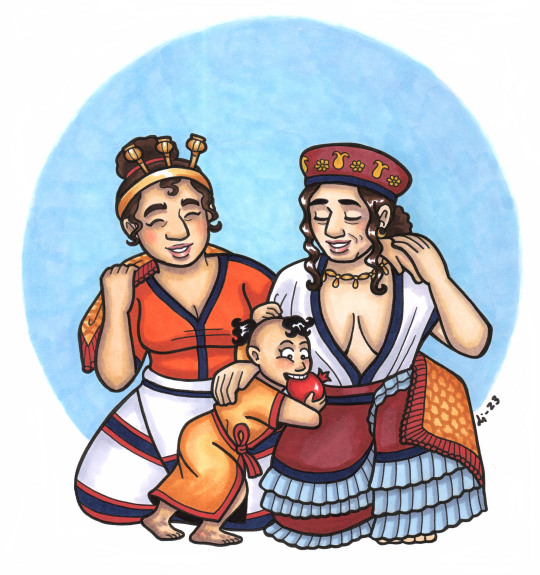
4: Rhea, Demeter, and Kore
Drawn after the ivory triad from Mycenae, fourteenth or thirteenth century BCE. It has been interpreted as two goddesses and a divine child. I have a version of this in my comic Destroyer of Light as well.
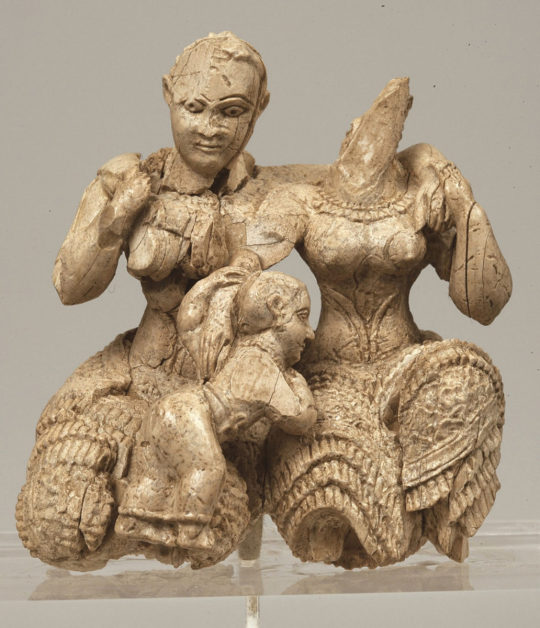
197 notes
·
View notes
Text

A seated goddess before a procession of seahorses. Mycenaean gold ring, artist unknown; 15th cent. BCE. From Tiryns; now in the National Archaeological Museum, Athens. Photo credit: Zde/Wikimedia Commons.
#classics#tagamemnon#Ancient Greece#Mycenaean Greece#Aegean Bronze Age#art#art history#ancient art#Greek art#Ancient Greek art#Aegean art#Bronze Age art#Mycenaean art#ring#jewelry#jewellery#metalwork#gold#goldwork#NAM Athens
2K notes
·
View notes
Text
From Apollo and Artemis with Love
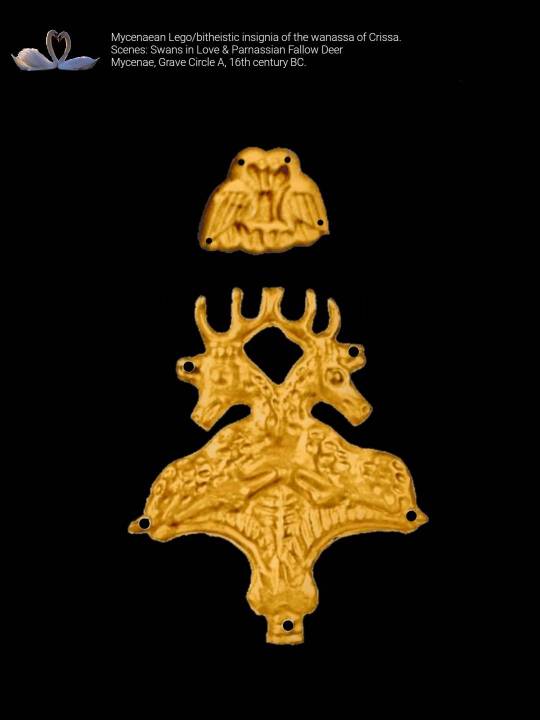
Swans in Love & Parnassian Fallow Deer. Matriarchal insignia of Mycenaean wanassa. National Archaeological Museum of Athens.
3,500 years ago, the Mycenaeans had not yet heard of the Olympian gods Apollo and Artemis, but they already revered their birds and animals. They considered the snow-white swans to be divine, and the long-necked does lived in the pine groves at the foothills of the sacred two-headed Parnassus Mountain.
Like the legendary hinds of the Artemis' Moon Chariot, the Mycenaean crescent fallow deer are from Parnassus too. They were symbols of that breathtaking place, and served as the sacred animals of the goddess.
For the people of the Bronze Age, swans in love conveyed the same meaning as they do today. It's an eternal image, symbolizing fidelity forever, purity, and love.
The reflected light penetrating down between the crowns of the pines fell on the horns of the fallow deer. The horns appeared golden, while the hooves remained in the shadows.
Artemis caught four fallow deer and harnessed them to the Moon Chariot. The fifth one ran away. Even Hercules chased it for a whole year, so fast and tireless was the Hind.
Swans were considered to be Apollo's birds, and fallow deer were his twin sister's animals. The Apollo swans were believed flew from Hyperborea.
Perhaps the deities of Mount Parnassus were brother and sister too. Like Apollo and Artemis, like the Sun and the Moon.
***
(The images for these collage drafts are taken mainly from Wikipedia, fallow deer are from the book: "Mycenae: A Journey in the World of Agamemnon" by Alkestis Papadimitriou, Elsi Spathari).
#apollo#parnassus#Crissa#Delphi#prehistoric animals#mycenaean art#Artemis#Cygnus Hyperboreus#long-necked
2 notes
·
View notes
Text



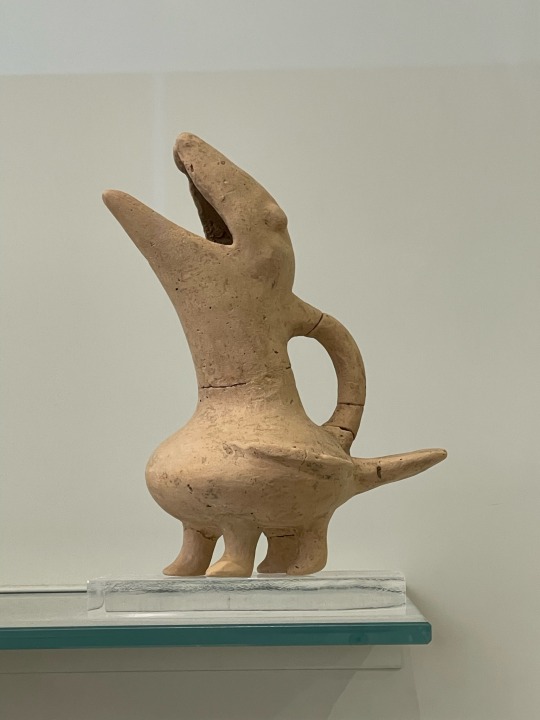
I had the immense privilege of going to Greece earlier this summer. I took 400 pictures of ancient pottery and came home inspired to put octopodes on everything.
1. My octopodes on some tiny vases and a cup
2. My reference photo of a Mycenean amphora with an octopus in the Minoan Marine Style, 1500s BCE. (National Arcaelogical Museum, Athens)
3. My bird jug with printed reference photo
4. Bird-shaped vessel from Crete, 2700 - 1900 BCE (Heraklion Archaelogical Museum, Heraklion)
2K notes
·
View notes
Text

i don’t know why odysseus was so scared of a bunch of women, what an incel (circes island)
#calculating how much a post is going to bomb on the “effort put in” to “attention gained” inverse ratio#no but genuinley i love my art rn i’m in my moment#ancient greek#greek mythology#minoan#mycenaean#digital art#digital painting#circe#epic the circe saga#circes island#fanart#tsoa#odessey
757 notes
·
View notes
Text

Odyssey's ship leaving Ithaca (2024)
Penelope and Telemachus look at Odysseus's ship sailing away...
Illustration for Homer's Odyssey
#marysmirages#mycenaean greece#ancient greek mythology#bronze age#odysseus#odyssey#penelope#telemachus#art#homer#ship#sea#ancientgreece
708 notes
·
View notes
Text

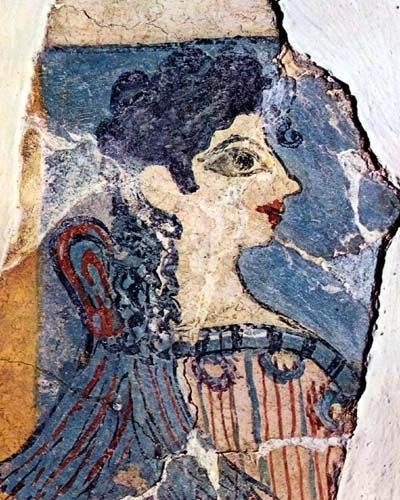
Sketchbook - Minoan and Mycenaean Art serie
758 notes
·
View notes
Text

The Tomb of Agamemnon by Louis Jean Desprez
#agamemnon#tomb#art#louis jean desprez#greek mythology#mycenae#mycenaean#king#architecture#funeral#ancient greece#ancient greek#history#antiquity#classical antiquity#europe#european#greek#greece#mythology#ancient#ancient world#funerals
549 notes
·
View notes
Text
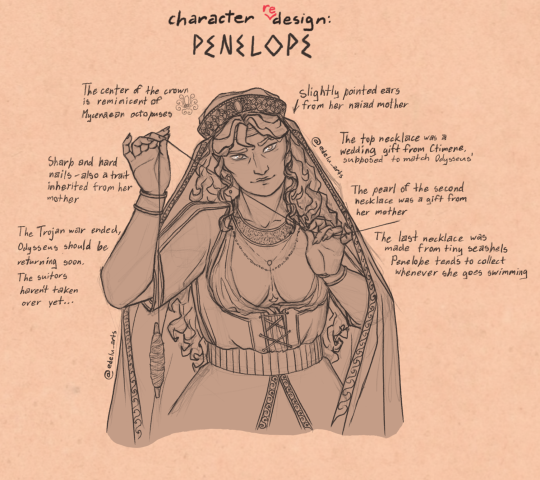
Really happy with how she turned out! I decided to give her some naiad features, inspired by this post and it was really fun! I hc that she can breathe underwater (even though she doesn't have gills. Do naiads have gills?), although I am not sure if she can do it freely or for a limited amount of time 🤔
The fabric piece covering her chest was loosely inspired by 18th century neckerchiefs, because I wasn't sure how the Mycenaean open chest fashion would fly with the censorship here or on other platforms ¯\_(• ▽ •;)_/¯
#I can leave comments and reblog posts again#yay#the odyssey#tagamemnon#penelope#character design#my art tag#I hc that she took over Odysseus' duties while he was away and got to be a reigning queen for about 10-13 years#until the suitors took over. It's a pretty long rant and I can't fit it into tags#this is her design before that#her being a ruler wouldn't really have been possible by Homer's time because of how the ancient Greece treated women#but since the story was set in Mycenaean Greece... maybe? Just maybe she could have enough authority for the assembly to take her seriously#epic the musical#epic the musical fanart#greek mythology#maybe this hc would change as I learn more things about history#but for now it's here ¯\_(ツ)_/¯
425 notes
·
View notes
Text
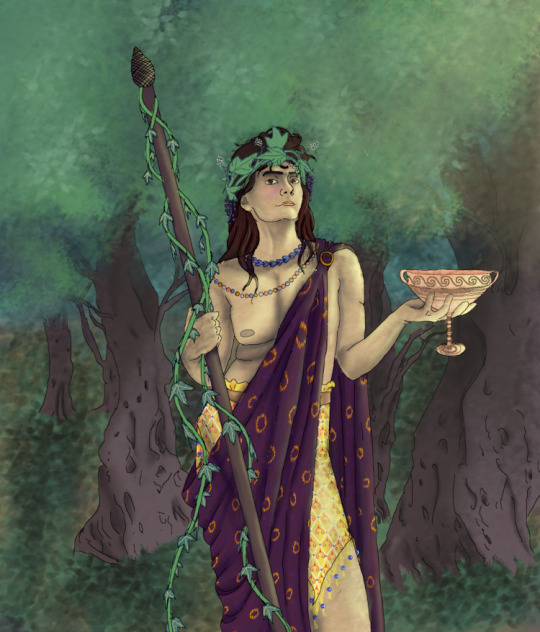
A Mycenaean inspired Dionysus. The kilt is inspired from the Processional Fresco at Knossos, with a stylised ivy leaf design. The original kilt with this pattern is blue, but yellow seemed more appropriate here. The necklace of blue beads is also the Mycenaean stylised ivy leaf, based on archaeological finds. The way the two necklaces are inspired by the Knossian 'Priest King/Prince of the Lilies'. He wears a crown of vine leaves and flowers. The cloak was because I felt that a purple would contrast better than a leopard skin (which would add more tawny colours). I've taken inspiration from the leopard with the golden rosettes, contrasting against a wine-dark fabric.
238 notes
·
View notes
Note
Why do some of your characters (Aphrodite, Hecate, and Dionysos when he was getting married) have patterns of red dots on their cheeks? What culture/tradition is that from historically, and why is it worn by only those particular characters?
And why was Dionysos’s face painted bright white when he was getting married (like the world’s most beautiful clown, lol)? I really love it, especially since it reminds me of a mask which is fitting for the god of theatre.
I have taken those red dotted rosettes from this Mycenaean sculpture (the Mycenaean civilization flourished in Greece between c. 1700 and 1100 BCE. They were the first people to speak the Greek language).

We don’t know if this female figure was a priestess, a goddess or maybe a sphinx. And we don’t know if the dotted rosettes on her face had some significance or if they were only decoration. I just thought that they looked nice and mysterious, and so were quite fitting for goddesses like Hekate (goddess of witchcraft) and Aphrodite (whose origin is quite mysterious in my telling).
As for Dionysos' white-colored face, it was inspired by this reconstruction of a Mycenaean noble woman. I thought it looked so incredibly cool (I'm drawn to things that are cute/beautiful but also a bit strange). Like you say, it reminds of a mask, which made it very fitting for Dionysos.
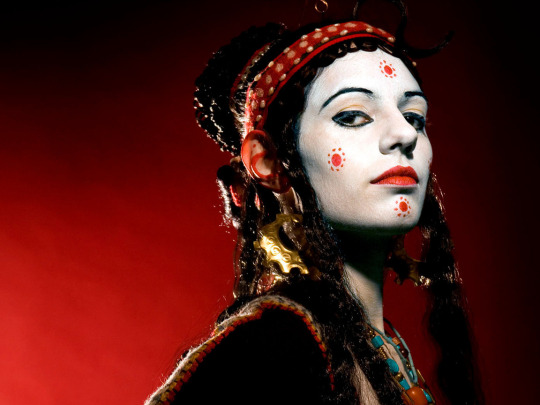
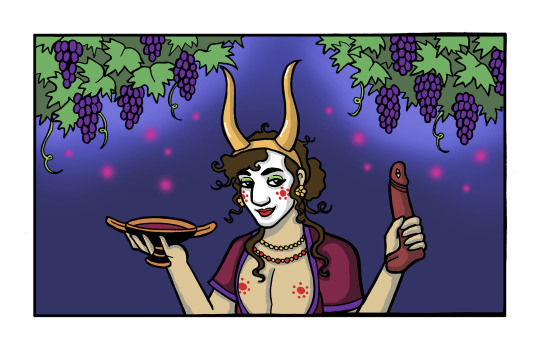
66 notes
·
View notes
Text
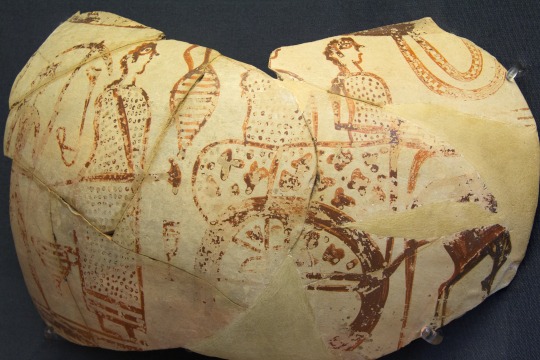
A chariot with charioteer and rider, followed by two walking figures. Fragment of a Mycenaean krater (mixing-bowl) by an unknown artist; ca. 1400-1350 BCE (Late Helladic IIIa1). Found in Tomb 67 at Enkomi, Cyprus; now in the British Museum. Photo credit: Zde/Wikimedia Commons.
#classics#tagamemnon#Ancient Greece#Bronze Age#Aegean Bronze Age#Mycenaean#Mycenaean Greece#Cyprus#Ancient Cyprus#art#art history#ancient art#Greek art#Ancient Greek art#Bronze Age art#Mycenaean art#Cypriot art#vase painting#krater#British Museum
183 notes
·
View notes
Text
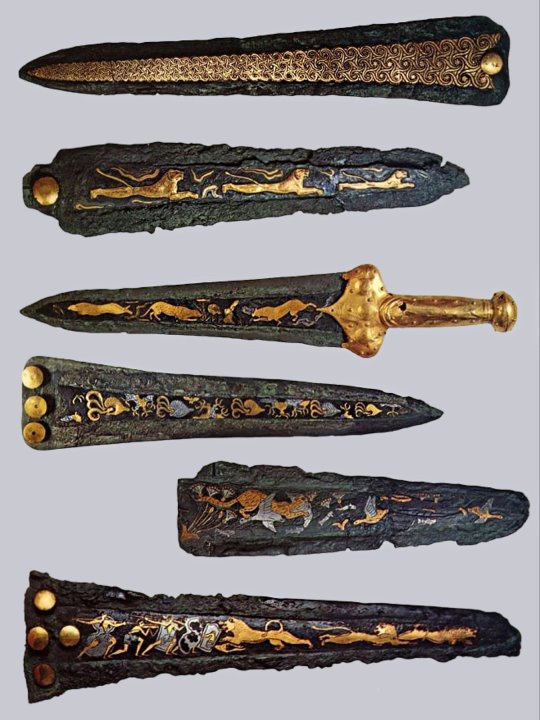
Mycenaean Swords with elaborate 'Gold Plating' (1600-1300 BC), Crete, Greece.
Sword with gold-capped rivet and gold plating on the hilt.
Small dagger with three gold-plated rivets.
Gold-plated hilt with repoussé decoration representing lions hunting goats, held in place by gold rivets and gold ring.
Sword with repoussé spiral motif on hilt.
Sword with five gold-plated rivets.
Courtesy: Archaeological Museum of Heracleion, Crete
#art#history#design#style#archeology#sculpture#crete greece#sword#dagger#gold -plated#mycenaean#1600BC#1300BC
242 notes
·
View notes
Text
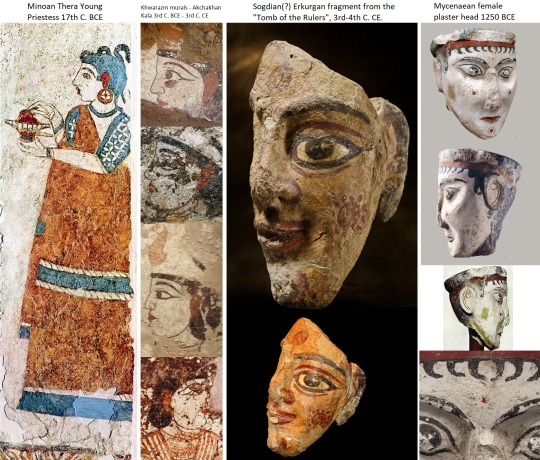
Comparison of Minoan, Mycenaean, Sogdian, & Khwarazm artworks 17th C. BCE - 4th C. CE
When I came across the Khwarazm (aka Chorasmian) murals I remembered this red-eared priestess from Thera. Their large eyebrows, red-painted ears, extremely light skin tone, and general facial features look very similar to each other despite being over 1,000 years apart and in different regions of the world. Other than that their clothing, jewelry, and hairstyle are quite different. I couldn't figure out what the significance of the red ears were, though Jason Earle speculates it might be an artistic depiction of a person hearing something divine from a deity (Cosmetics and Cult Practices in the Bronze Age Aegean? A Case Study of Women with Red Ears). These are the only images I've come across, that I can recall, of people with their ears painted red so I felt like comparing them.
The Erkurgan fragment has red solar symbols very similar to the Mycenaean plaster head. Again these two pieces of art are over 1,000 years apart and in different geographic locations. I don't know who the Erkurgan fragment should be attributed to, but this was a place in the heart of Sogdiana. I assume it represents a Sogdian because of location and time period, but that's just my assumption. Solar symbols appear in basically all civilizations, but I've never come across these specific red styled ones (that I can recall) except in these two instances. In both instances they appear on the cheeks, forehead, and probably the chin (the Erkurgan fragment's chin is damaged but seems to have some red paint). Again, seeing this unique symbol made me feel I should compare the two. From what I've read all the images here are generally thought to be depictions of females with religious significance.
#minoan#mycenaean#art history#ancient history#ancient#art#antiquities#history#paganism#pagan#goddess#priestess#indo european#ancient art#archaeology#anthropology#sogdiana#ancient greece
272 notes
·
View notes
Text

Myrmidons (Achilles plays the harp for Patroclus) Gouache Version (2024)
#marysmirages#mycenaean greece#ancient greek mythology#bronze age#iliad#achilles#patroclus#patrochilles#dog#harp#sea#seascape#myrmidons#tagamemnon#art#painting
584 notes
·
View notes
Text
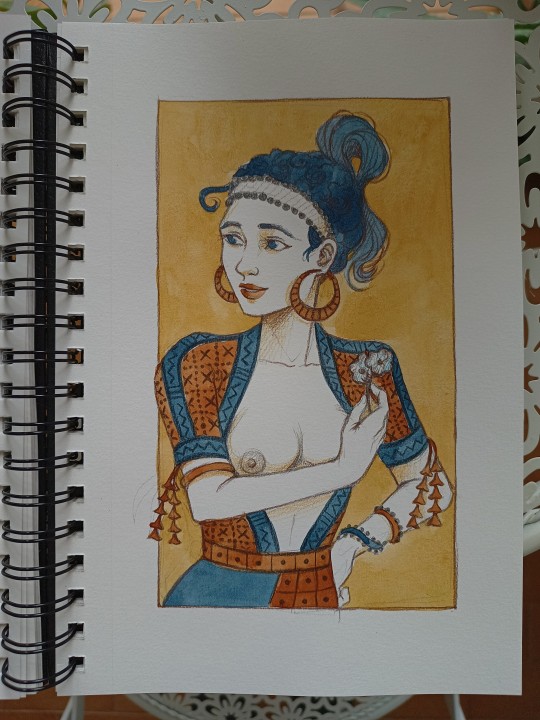

Sketchbook - Minoan and Mycenaean Art serie
584 notes
·
View notes